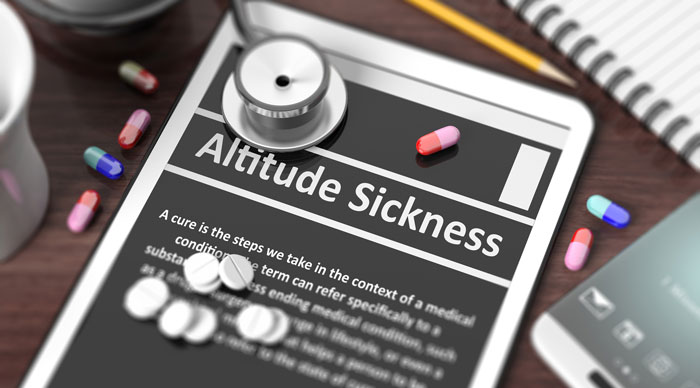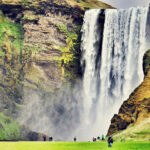What is altitude illness?
Altitude sickness occurs due to a lack of oxygen and air pressure to meet the demands of ones body as you ascend. At sea level and below 8000 ft, there is sufficient air pressure and oxygen, however as you ascend up the mountain, pressure starts to drop and therefore oxygen levels drop also. Altitude sickness occurs when your body is unable to adapt to the changes in air pressure and oxygen levels.
How is altitude illness caused?
It is a result of lack of oxygen. While the atmosphere will always have 21% oxygen the driving pressure decreases the higher we go. At sea level the driving pressure forces sufficient oxygen into the capillaries of our lungs giving saturation of oxygen in the blood and throughout the tissues. However, as we start to ascend an ever decreasing driving pressure also implies an ever decreasing oxygen level, giving less oxygen into the capillaries of our lungs and subsequently less oxygen in our blood and tissues. Up to an altitude of around 8,000 feet the driving pressures should be high enough to provide sufficient oxygen levels. When entering terrain of 8,000 feet and higher pathophysiological changes may start to manifest due to lack of oxygen.
What are altitude illness symptoms?
AMS is the most common of the three altitude illness conditions and is normally the predecessor of the two other and more serious conditions. AMS consists of headache plus any one of the following symptoms in varying degrees:
- Nausea
- Tiredness
- Sleeplessness
- Dizziness
- Social withdrawal
- Swelling extremities
AMS may set in within hours or days having been in altitudes above 8,000 ft. The onset of symptoms is usually gradual and when trekking it is therefore important to continuously be watching out for early warnings such as excessive tiredness and/or headache.
High Altitude Cerebral Edema (HACE) is a more serious condition probably caused by shifts of fluids due to reduced pressure into the tissues of the brain which causes swelling within the confines of the skull. The result is a higher skull pressure that may lead to lethargy and eventually coma. The symptoms of HACE are an extension to those of AMS – from being weak or fatigue, there is progression to lethargy and then to coma, and/or – there may be confusion, disorientation and walking disturbance (in which case a test should be made to see whether the person can walk straight, following a line) Anybody believed to have symptoms of HACE should immediately descend with assistance from others. This situation is serious enough to justify helicopter evacuation as if HACE is progressing to much it may ultimately lead to death.
High Altitude Pulmonary Edema (HAPE) is another serious condition which may either be following AMS or appear independently without any signs of AMS. As a result of low oxygen level and pressure levels the pulmonary artery may narrow resulting in exudation of blood near the smaller branches of the lungs. A prolonged exudation may result in blood escaping into the aveoli leading to coughing with watery blood-tinged phlegm. Such exudation of the lung tissue may interfere with the oxygenation causing shortness of breath even at rest. The symptoms of HAPE are:
- Shortness of breath at rest
- Extreme fatigue
- Gurgling respiration
- Dry cough or wet cough with frothy sputum
If HAPE is left untreated it can progress to respiratory collapse and ultimately to death.
How to prevent altitude illness?
The best way to prevent altitude sickness is to ascend gradually. When above 3,000 m it is not recommended to ascend more than 300-400 m per day. Even if you’ve not ascended more than 300 m but still feel a headache, tiredness or any other of the above listed altitude sickness symptoms, always take a rest day to further acclimatize. Moreover, keep on drinking enough water so as to stay hydrated. Proper hydration helps to prevent altitude sickness. Please therefore also always stay away from alcohol when trekking. The general water drinking guideline is to drink 1 liter of water per 1000 m. To exemplify, if at 4,000 m then 4 liter of water should be consumed per day, if at 5,000 m then 5 liter of water etc.
Another recommended way to prevent altitude sickness is the use of Diamox (Acetazolamide) pills so as to speed up the acclimatization. As soon as you ascend more than 3,000 m you can start taking 1 pill per day. Alternatively only take Diamox pills if starting to feel any of the altitude sickness symptoms.
How to treat altitude illness?
- Always consult a doctor if available.
- In case of mild altitude sickness symptoms, stay at the same altitude, take it easy, get plenty of sleep, drink enough water and perhaps start to take Diamox pills. In case the altitude symptoms do not get better within 1 day, start to descend. Never let a person suffering from altitude sickness descend alone.
- In case of serious altitude sickness symptoms start to descend immediately. Consider getting a helicopter emergency evacuation.
- Serious altitude sickness symptoms may be treated with a Gamow bag which is a inflatable high pressure bag which helps to restore the oxygen level and air pressure.
For more information on Altitude Illness please check out Himalayan Rescue Association.
We hope the above answers any questions you may have to Health and Safety. If not, please do write to us here.










